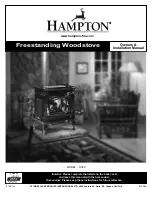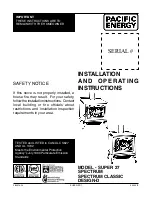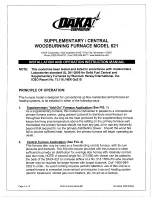
26
particularly if they are made of old or
porous brick and / or are jointed with
lime mortar, eventually causing
unsightly stains on decorative coverings.
• Stoves work best with the correct
draught. Pre-1965 chimneys which have
been built for open fires have larger
(and irregular shaped) voids than those
best suited for a modern stove and
thus could reduce the effectiveness of
the flue draught by making the flue
too cold and difficult to warm. This is a
particular problem if the chimney breast
is on an outside wall and / or is subject
to a strong prevailing wind.
• The interior surfaces of older flues
could be eroded and also have rough
surfaces which could cause resistance
to the flow of gases and consequently
result in poor up-draught.
• Unfortunately many houses built
since 1965 with clay or concrete
chimney liners suffer from these being
poorly installed, either through being
fitted the wrong way up or not
receiving an appropriate application
of mortar to make a complete seal on
each joint. Even though not particularly
old, this could still potentially cause
leaking smoke and fumes or
condensation stains
Your approved installer will be able to
advise you on the suitability of your
chimney after undertaking a thorough
inspection and smoke test. Any solid
fuel flexible liner which is specified
should be double skinned stainless
steel, either 904L or 316Ti grade and be
CE marked and / or Hetas Approved.
have been used also have inspection
hatches, irrespective of any other
hatches in the system.
Since stoves create flue gases at a much
greater temperature than those
produced by an open fire or gas
appliance it does not necessarily follow
that your chimney will function
adequately (or safely) when your new
stove is installed. The best way to
ensure that you have a fully functioning
flue system is to fit an approved flexible
multi fuel flue liner.
Current building Regulations in England
and Wales do not yet automatically
require an existing chimney to be lined
when a new stove is fitted. However,
Alpha strongly recommend fitting a
liner for the following reasons:
• A flue liner is a major ‘quantifiable’
component in a total and fully
functioning flue system. As such it will
provide a consistent flue draught from
the stove through to the chimney
terminal and when back-filled with
vermiculite will deliver much needed
insulation to keep flue gases as hot as
possible which will help minimise the
amount os smoke produced. It will
also improve the stove’s operation with
greater control over the fuel burn rate
and improved environmental and fuel
efficiency.
• Your existing chimney could leak
smoke, fumes and potentially
dangerous ‘invisible’ carbon monoxide
into other parts of the building.
• Condensation or creosote ‘tar’, often
associated with burning wood, could
eventually seep through the walls,














































